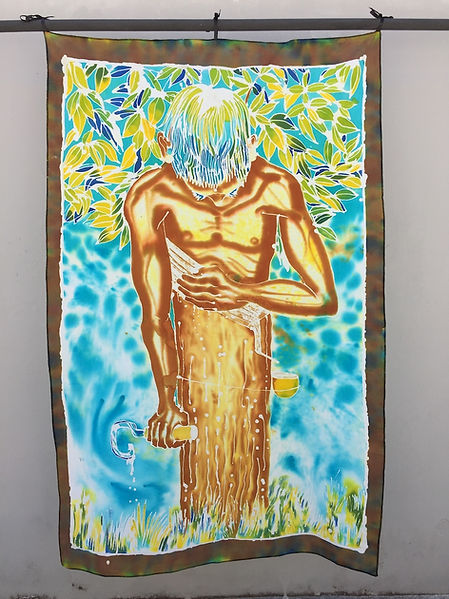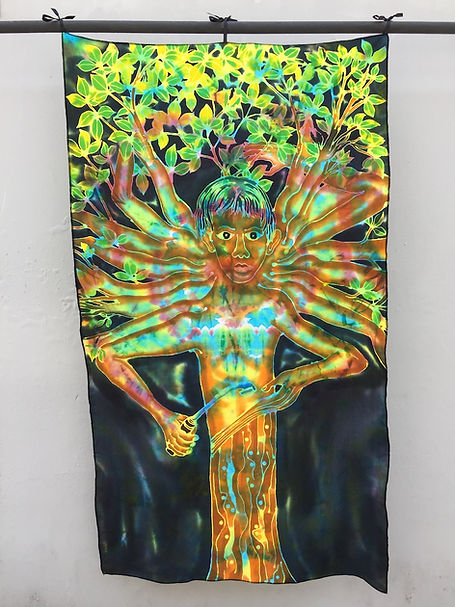A LEAF THROUGH HISTORY: FAMILY TREE 2017-2022 (scroll down for artist's statement & video)

A Leaf Through History: Family Tree
2022
batik on cloth with wooden rod attached to rubber tapper's knives (installation)
440cm x 540cm x 90cm
_JPG.jpg)
_JPG.jpg)
_JPG.jpg)
_JPG.jpg)
_JPG.jpg)
_JPG.jpg)
_JPG.jpg)
_JPG.jpg)
_JPG.jpg)
_JPG.jpg)
_JPG.jpg)
_JPG.jpg)
_JPG.jpg)
_JPG.jpg)
_JPG.jpg)
_JPG.jpg)
_JPG.jpg)
_JPG.jpg)
_JPG.jpg)
_JPG.jpg)
_JPG.jpg)
_JPG.jpg)
_JPG.jpg)
_JPG.jpg)
_JPG.jpg)
_JPG.jpg)
_JPG.jpg)
_JPG.jpg)

ARTIST STATEMENT: A LEAF THROUGH HISTORY
“The most popular motifs are leaves and flowers. Malaysian batik depicting humans or animals are rare because Islam norms forbid animal images as decoration. However, the butterfly theme is a common exception.”
I come across this phrase on many occasions. It’s repeated so many times that I have come to accept, like many things in Malaysia, that there is a dominant narrative/rule that we simply have to follow. However, through my travels and exploration of batik in Indonesia and Japan, and my month-long residency in Kelantan to learn the craft, I discovered there’s a rich tradition as well as experimentation on batik. In modern Malaysian visual art, batik painting was a popular medium during the years around our nation’s independence. Perhaps these artists associate batik with our country’s nascent identity and potential, with their depiction of idyllic kampong life where people toiled the land to sustain their lives and spirit in a dream-like harmonious dance with nature and progress.
Since moving out of the capital, Kuala Lumpur, and in search of a simpler life to concentrate on art-making, I have discovered the small town I have translocated to: Tangkak, Johor, has its origin in agriculture. From planting vegetables, it has gone through different cycles of plantations on the same plot of land with each new cash crop covering the previous' existence. I am wondering does that also apply to our own existence: Does the new narrative of what Malaysia is covers the layers of our past existence?
Therefore I am embarking on a series of batik artworks questioning these floral and butterfly motifs. I hope to elevate these motifs from mere decoration and decorum. I want to explore these motifs as a way to understand the history of cash crop plantations in this country. It is a glimpse into the landscape of profit, invasion, colonialism, exploitation and ecosystem. As well as migration, setting down root and preserving traditions. Amongst the rows of plants are hidden joy, hunger, love, envy, friendship and violence. And when unprofitable crops are replaced by newer ones, the ground beneath us is overturned and everything that came before is covered in dirt while we live on the surface of things and pretend Malaysia is all leaves, flowers and butterflies.
Malaysia was once the largest natural rubber producer in the world. The latex flowing out of the skin of the rubber trees is like the wax of the batik, which is paramount in forming the patterns on the cloth, but removed once it served its purpose, like the rubber tappers. I want to re-build a rubber plantation out of batik cloth; a monument for forgotten rubber tappers. A monument for forgotten Malaysia.
CHANG YOONG CHIA
28 June 2022
click for video



